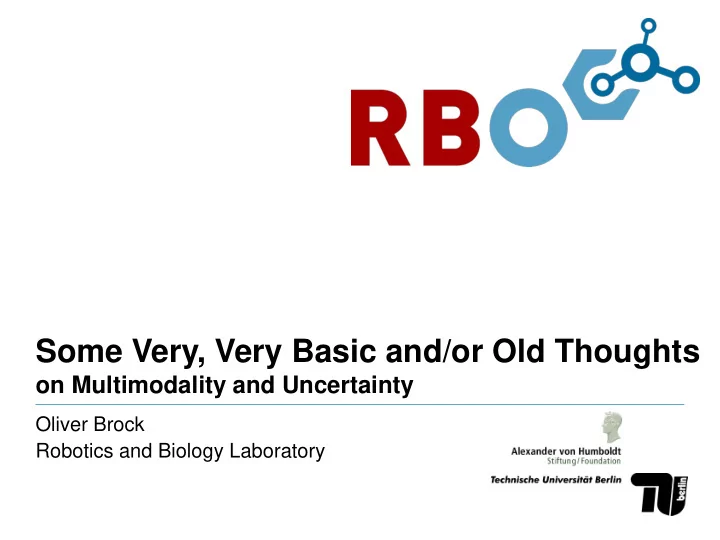

Some Very, Very Basic and/or Old Thoughts on Multimodality and Uncertainty Oliver Brock Robotics and Biology Laboratory
The Amazon Picking Challenge
The Problem
Possible Reasons for Winning… ► Luck ► Bigger team ► Graduate students versus undergraduates ► Cheating ► Embodiment ► Vertical integration (behavior) ► Better boxes: Factorization ► Embodiment ► Biases / priors / heuristics ► Project management ► Really smart people
Embodiment Choices
Boxes
VISION
Prior Knowledge for Segmentation
Projecting to 1D Color (Hue + B/W) Hue + white/gray/black
Probabilistic Segmentation P(Color | Object) Backprojection Bayes' rule
More Features! Color Height (3D) Edges Height (2D) Combine Segment 3D missing Distance to shelf
APC Segmentation Results
Importance of Each Feature
James J. Gibson (1904 – 1979) Eleanor J. Gibson (1910 – 2002) 1966
Prog. by Demo Prog. By Demo Kinematics Surveillance Activity Objects Manipulation
“Learning to See”
Experimental Design 576-dimensional observation 10/10/2015
Training (~ 50 minutes)
Test of Learned Behavior
What the Robot Sees and How It Learns
Learning to See robotics prior state reinforcement learning action 10/10/2015 32 Rico Jonschkowski
Learning to Perceive
Learning to Perceive
Moving in An Environment With Disturbances
Moving in a “Cluttered” Environment (Robot’s View)
Performance
Different Learned Representations
How Do We Do It? Rico Jonschkowski William of Ockham Sir Isaac Newton 1287 – 1347 1642 – 1727 1987 –
Five Robotic Priors Simplicity Only a small number of world properties are relevant. Task-relevant properties of the world change gradually. The task-relevant properties together with the action determine the reward. The amount of change in task-relevant properties resulting from an action is proportional to the magnitude of the action. The task-relevant properties and the action together determine the resulting change in these properties.
Functional Relationships between DOF
Online IP: Three Recursive Estimation Problems spatial coherency rigid body physics kinematics feature motion rigid body motion kinematic model measurement input input to process model
Visual Odometry and Online IP
spatial coherency rigid body physics kinematics feature motion rigid body motion kinematic model rigid body motion shape reconstruction (shape) rigid body physics shape appearance
Effect of Integrated Tracking on Reconstruction Integrated Tracking Non-integrated Tracking
Robotic Senses Considered as a Perceptual System PRIOR PRIOR PRIOR ESTIMATION ESTIMATION ESTIMATION PRIOR PRIOR PRIOR ESTIMATION ESTIMATION ESTIMATION PRIOR PRIOR PRIOR ESTIMATION ESTIMATION ESTIMATION
Layers of the Cortex / Connectivity of Visual Cortex
Uncertainty: the Ruler of Perception
Roberto Martín Martín Sebastian Höfer
Our Options Against Uncertainty ► Ignore it! Assume you know everything! (Ignore this.) ► Model it and then go back to the above ► Let the physics of interaction deal with it ► Stay in regions of the space (what space?) where uncertainty is not (that) relevant to task success
Modeling it and then Go Back to the Above Assumption: Only the world is a truthful and complete model of itself.
Explicit Reasoning about Uncertainty cost of modeling benefit/cost and computation High Low no uncertainty as much uncertainty as possible
Let the Physics of Interaction Deal with It
Pisa/IIT Soft Hand
How to Identify Regions of Robust Interaction? This slides was intentionally left blank.
Clemens Eppner Raphael Deimel Jessica Abele
Conclusion How? What? PRIOR PRIOR PRIOR ESTIMATION ESTIMATION ESTIMATION Don’t try to model the world! PRIOR PRIOR PRIOR Instead, try to model robust, ESTIMATION ESTIMATION ESTIMATION task-relevant correlations in action and perception space. PRIOR PRIOR PRIOR ESTIMATION ESTIMATION ESTIMATION INTERACTIVE PERCEPTION
Recommend
More recommend